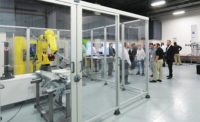iSuppli: CCDs Drop in Image Sensor Market as CMOS Grows
The demand for charge-coupled device (CCD) image sensors appears to be decreasing as digital cameras - their primary application - switch to a less expensive and more efficient rival technology: the complementary metal oxide semiconductor (CMOS) sensor, according to market research firm iSuppli (El Segundo, CA).
In the total market for image sensors - devices that convert an optical image into an electrical signal - the unit share of CCD sensors continues to decrease in 2010 compared to that of the competing CMOS technology.
Of the total 1.7 billion units forecasted for the image sensor market this year, CCDs will account for a roughly 9.8% share, down from 11.4% in 2009. And while the decrease in unit share is slight, the trend appears to be irreversible, with CCD sensors to make up 4.7% of the market by 2014.
In contrast, the CMOS image sensor market will expand its unit share of the market to 90.2%t this year, claims iSuppli, up from 88.6% in 2009. The increase is borne on the back of growing demand from equipment like cameras in mobile handsets, video conferencing, and automotive driver-assist applications.
The figure shows the unit share of market for CCD and CMOS image sensors, from 2009 through 2014.
While CCDs long had been thought of as a superior technology for image quality, CMOS technology has made great strides in recent years and narrowed the technology gap,” says Pamela Tufegdzic, analyst for consumer electronics at iSuppli. “Furthermore, CMOS sensors use fewer components, consume less power and are cheaper to manufacture.”
And although CMOS has been the main technology for some time now in handsets and high-end digital cameras called DSLRs, CMOS penetration continues to increase in lower-end, point-and-shoot digital still cameras - traditionally a CCD application. As a sign of their growing usage, CMOS sensors are gaining traction in compact cameras and camcorders from brand-name manufacturers that used CCDs for those products in the past - industry names such as Canon Inc., Sony Corp., Samsung Electronics, Eastman Kodak Co., Casio Computer and JVC - iSuppli has determined.
The migration to CMOS from CCD will continue for point-and-shoot cameras. By next year, the proportion of point-and-shoot models using CMOS will climb to 24%, up from 14% in 2009, says the firm.
The shift to CMOS among DSLR cameras is occurring even faster : By 2014, iSuppli anticipates 99% of DSLR models will be based on CMOS sensors.
In the total market for image sensors - devices that convert an optical image into an electrical signal - the unit share of CCD sensors continues to decrease in 2010 compared to that of the competing CMOS technology.
Of the total 1.7 billion units forecasted for the image sensor market this year, CCDs will account for a roughly 9.8% share, down from 11.4% in 2009. And while the decrease in unit share is slight, the trend appears to be irreversible, with CCD sensors to make up 4.7% of the market by 2014.
In contrast, the CMOS image sensor market will expand its unit share of the market to 90.2%t this year, claims iSuppli, up from 88.6% in 2009. The increase is borne on the back of growing demand from equipment like cameras in mobile handsets, video conferencing, and automotive driver-assist applications.
The figure shows the unit share of market for CCD and CMOS image sensors, from 2009 through 2014.
While CCDs long had been thought of as a superior technology for image quality, CMOS technology has made great strides in recent years and narrowed the technology gap,” says Pamela Tufegdzic, analyst for consumer electronics at iSuppli. “Furthermore, CMOS sensors use fewer components, consume less power and are cheaper to manufacture.”
And although CMOS has been the main technology for some time now in handsets and high-end digital cameras called DSLRs, CMOS penetration continues to increase in lower-end, point-and-shoot digital still cameras - traditionally a CCD application. As a sign of their growing usage, CMOS sensors are gaining traction in compact cameras and camcorders from brand-name manufacturers that used CCDs for those products in the past - industry names such as Canon Inc., Sony Corp., Samsung Electronics, Eastman Kodak Co., Casio Computer and JVC - iSuppli has determined.
The migration to CMOS from CCD will continue for point-and-shoot cameras. By next year, the proportion of point-and-shoot models using CMOS will climb to 24%, up from 14% in 2009, says the firm.
The shift to CMOS among DSLR cameras is occurring even faster : By 2014, iSuppli anticipates 99% of DSLR models will be based on CMOS sensors.
Looking for a reprint of this article?
From high-res PDFs to custom plaques, order your copy today!



